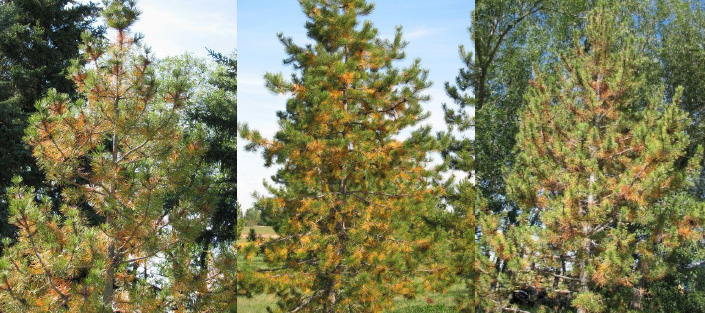Seasonal/Fall Needle Drop Fact Sheet
As fall is giving us spectacular leaf colours from hardwood species, the fall needle drop is a natural phenomenon that occurs in pine, spruce, fir, and arborvitae trees during the season. It is a process in which these trees shed their older needles, making way for new growth and ensuring the overall health and vitality of the tree. This shedding of needles is an essential part of the tree's life cycle and plays a crucial role in its adaptation to changing environmental conditions.
Symptoms and Identification
Depending on each coniferous species, older needles stay on trees for different time lengths. Pines will usually keep their needles for 4-8 years. Spruces typically keep their needles longer than pines do, generally for 5-10 years. Arborvitae sheds branchlets as they age yet remain on the tree for quite some time before falling.
The fall needle drop (yellowing of needles) occurs uniformly across the entire tree, from its uppermost branches to the lower ones. As fall approaches, the older needles on the inside of the tree canopy and closer to the tree trunk will transition from their usual green to hues of yellow, brown, or reddish-tan. Younger needles remain green, healthy and vigorous, with healthy apical buds.
It is very important to differentiate between fall needle drop and other tree health issues. Any irregularity, such as abnormal branch die-off or an uneven pattern of needle shedding, indicates a deviation from the normal fall needle drop process. In such cases, further investigation is warranted to identify underlying issues that trees may be suffering from, such as a more serious disease or insect problem.
Reasons for Fall Needle Drop
The process of fall needle drop is regulated by various environmental cues and internal hormonal and cellular changes within the tree. These cues include changes in daylight duration, temperature, and soil moisture levels. One of the most common causes of excessive needle drop is too-wet or too-dry soil.
As the days shorten and temperatures drop, trees begin preparing for winter. Coniferous trees optimize their resources by shedding older needles. These needles have lower photosynthetic activity compared to newer ones and shedding them helps conserve energy and nutrients.
Shedding older needles further reduces water loss, aiding the tree in surviving the drier conditions often associated with the fall season. Lastly, older needles are more susceptible to diseases and infestations by pests. Shedding them helps the tree maintain its overall health and reduces the risk of infections that could potentially harm the entire tree.
Benefits of Fall Needle Drop
Fall needle drop has important several ecological benefits, such as nutrient recycling, providing wildlife habitats, and reducing soil erosion. The needles that fall to the ground serve as a source of nutrients for the soil. Over time, these needles decompose, releasing valuable nutrients that enrich the soil and promote the growth of other plants in the ecosystem.
The fallen needles create a layer of organic material on the forest floor, providing habitat and protection for a variety of insects, fungi, and small organisms. This layer also supports the growth of understory plants that serve as food for many forest-dwelling creatures. The layer of needles on the forest floor helps reduce soil erosion by acting as a natural mulch. It protects the soil from the impact of heavy rain and promotes moisture retention.
Conclusion
Landowners don’t need be alarmed about fall needle drop as it is a natural and essential process for coniferous trees. There is no harm to trees during fall needle drop. Trees are just ensuring their adaptation to changing environmental conditions and promoting the overall health of the forest ecosystem. Understanding the symptoms of fall needle drop is crucial for tree owners, foresters, horticulturalists, and arborists to differentiate this natural process from potential tree health concerns.

Fact Sheet by Toso Bosic. ATTS Group Inc professional and experienced Tree Expert and ISA Certified Arborist offers a full range of consulting and advisory services to help you keep your trees healthy. You can connect with our Tree Specialist here: Our Tree Specialist
Contact Us
Saddle Hills
Junction of Hwy 49 & Secondary Hwy 725
RR1, Spirit River AB
T0H 3G0
T. 780-864-3760
Fax 780-864-3904
Toll-free 1-888-864-3760
frontdesk@saddlehills.ab.ca
Sign up to our Newsletter
Stay up to date on the Saddle Hills activities, events, programs and operations by subscribing to our eNewsletters.
